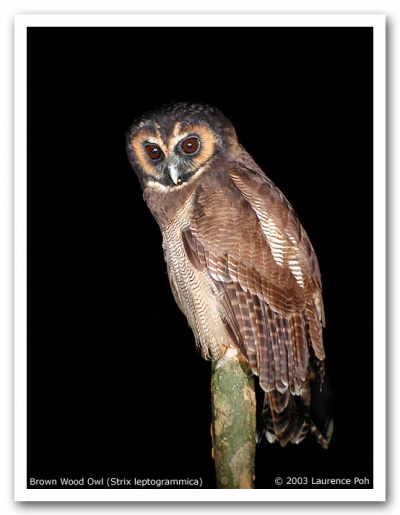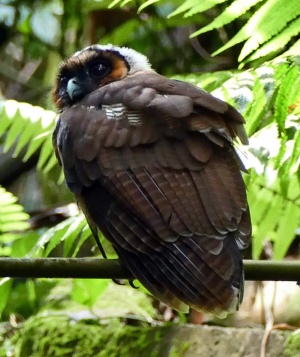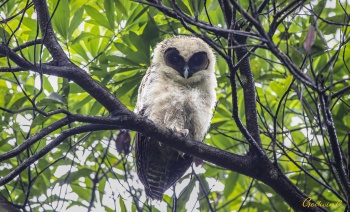(Picture of juvenile subspecies, front view. References updated) |
m (Photo date) |
||
| Line 18: | Line 18: | ||
==Taxonomy== | ==Taxonomy== | ||
====Subspecies==== | ====Subspecies==== | ||
| − | [[Image:TMS2226N.jpg|thumb|350px|right|Juvenile, Subspecies ''ticehursti''<br />Photo © by {{user|Godwin+Chan|Godwin Chan}}<br />[[Hong Kong]], June 2020]] | + | [[Image:TMS2226N.jpg|thumb|350px|right|Juvenile, Subspecies ''ticehursti''<br />Photo © by {{user|Godwin+Chan|Godwin Chan}}<br />[[Hong Kong]], 9 June 2020]] |
There are 14 subspecies<sup>[[#References|[1]]]</sup>: | There are 14 subspecies<sup>[[#References|[1]]]</sup>: | ||
*''S. l. newarensis'': '''Himalayan Wood-Owl''' [[Himalayas]] (Jammu and Kashmir to north-eastern [[India]]) | *''S. l. newarensis'': '''Himalayan Wood-Owl''' [[Himalayas]] (Jammu and Kashmir to north-eastern [[India]]) | ||
Revision as of 18:41, 21 June 2020

Photo by the late Laurence Poh
Temenggor Forest in North Perak, Malaysia, August 2003
- Strix leptogrammica
Includes Bartels's Wood-Owl; Himalayan Wood-Owl
Identification
39–55 cm (15¼-21½ in)
- Dark brown upperparts
- White spotted shoulders
- Buff, brown-streaked underparts
- White or whitish facial disc with brown or rufous rim
- Dark brown iris
- White neckband
Sexes similar
Distribution
Asia: found in China, India, Sri Lanka, Bangladesh, Bhutan, Taiwan
Southeast Asia: Indochina, Myanmar, Laos, Vietnam, Cambodia, Thailand, Malaysia, Malay Peninsula, Brunei, Borneo, Indonesia, Greater Sundas, Sumatra
Taxonomy
Subspecies
There are 14 subspecies[1]:
- S. l. newarensis: Himalayan Wood-Owl Himalayas (Jammu and Kashmir to north-eastern India)
- S. l. ticehursti: Myanmar to south-eastern China, Thailand, northern Laos and northern Vietnam
- S. l. caligata: Hainan and Taiwan
- S. l. laotiana: Southern Laos and central Vietnam (Annam)
- S. l. indranee: Peninsular India
- S. l. ochrogenys: Sri Lanka
- S. l. maingayi: Southern Myanmar, southern Thailand and Malay Peninsula
- S. l. myrtha: Sumatra
- S. l. nyctiphasma: Banyak Island (off north-western Sumatra)
- S. l. niasensis: Nias Island (off north-western Sumatra)
- S. l. chaseni: Belitung Island (Java Sea off south-eastern Sumatra)
- S. l. vaga: Northern Borneo
- S. l. leptogrammica: Central and southern Borneo
- S. l. bartelsi: Bartel's Wood-Owl Java
Habitat
Dense lowland primary rainforest (broad-leaved and evergreen) and forest edges, up to 2,590m. Avoids human habitated areas.
Behaviour
Diet
The diet includes small mammals, especially rodents; also reptiles, grasshoppers and birds. A bird in Java is known to have eaten a bat.
Breeding
They nest in a tree cavity. The clutch consists of 2 eggs.
Vocalisation
They make a very low purring sound. Call is 3-4 short hoots.
References
- Clements, J. F., T. S. Schulenberg, M. J. Iliff, S. M. Billerman, T. A. Fredericks, B. L. Sullivan, and C. L. Wood. 2019. The eBird/Clements Checklist of Birds of the World: v2019. Downloaded from http://www.birds.cornell.edu/clementschecklist/download/
- Avibase
- Handbook of the Birds of the World Alive (retrieved Feb 2018)
- BirdForum Member observations
Recommended Citation
- BirdForum Opus contributors. (2025) Brown Wood Owl. In: BirdForum, the forum for wild birds and birding. Retrieved 14 May 2025 from https://www.birdforum.net/opus/Brown_Wood_Owl





